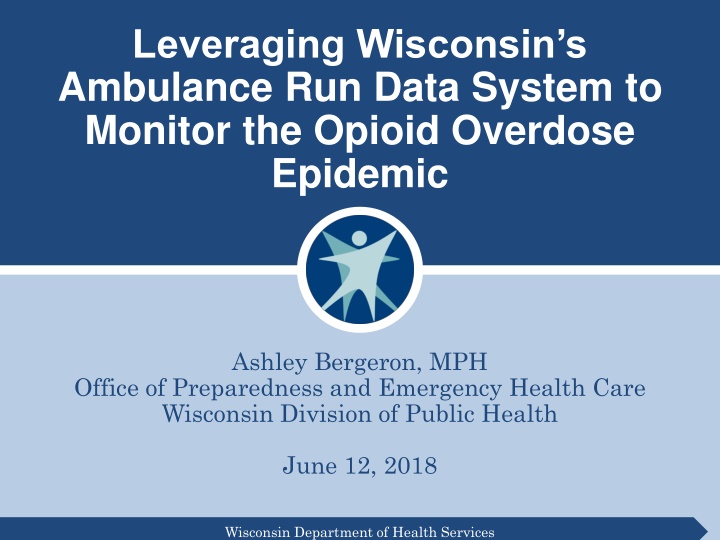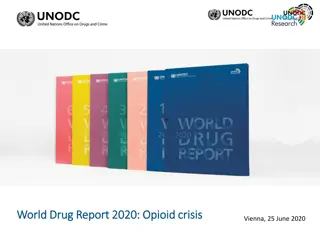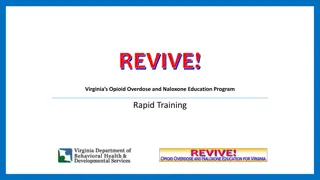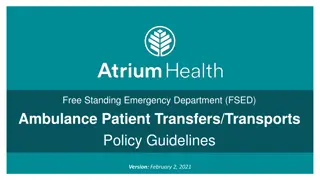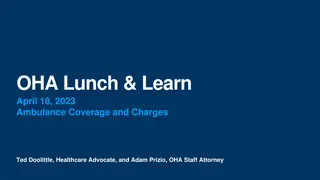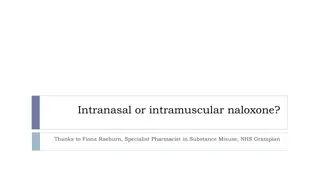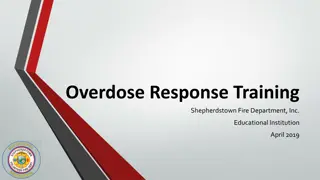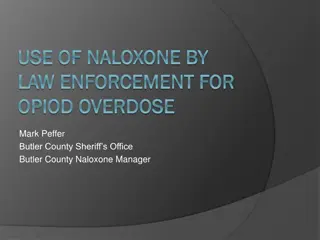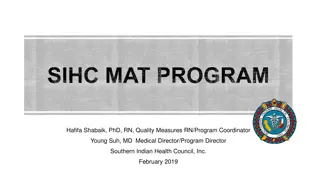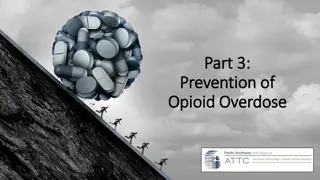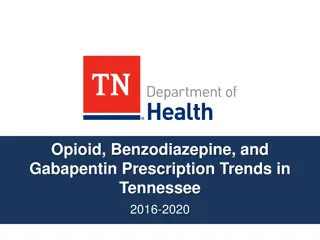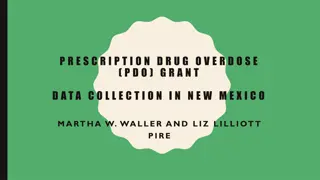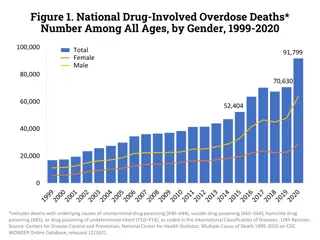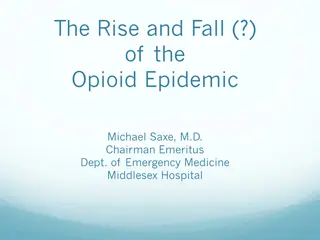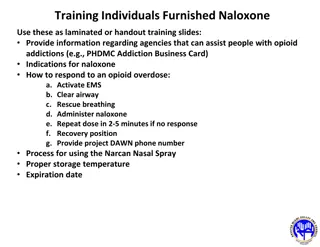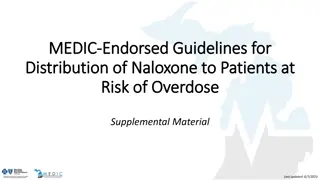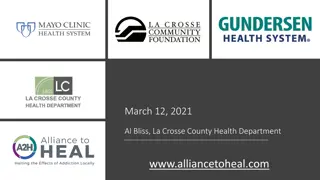Monitoring Wisconsin's Opioid Overdose Epidemic Through Ambulance Data
Utilizing Wisconsin's Ambulance Run Data System (WARDS), this initiative aims to enhance opioid overdose surveillance by analyzing nonfatal overdose data in real-time. By developing specific case definitions and identifying key variables of interest, the project seeks to improve the timeliness of monitoring opioid-related incidents and enhance public health safety in Wisconsin.
Download Presentation

Please find below an Image/Link to download the presentation.
The content on the website is provided AS IS for your information and personal use only. It may not be sold, licensed, or shared on other websites without obtaining consent from the author.If you encounter any issues during the download, it is possible that the publisher has removed the file from their server.
You are allowed to download the files provided on this website for personal or commercial use, subject to the condition that they are used lawfully. All files are the property of their respective owners.
The content on the website is provided AS IS for your information and personal use only. It may not be sold, licensed, or shared on other websites without obtaining consent from the author.
E N D
Presentation Transcript
Leveraging Wisconsins Ambulance Run Data System to Monitor the Opioid Overdose Epidemic Ashley Bergeron, MPH Office of Preparedness and Emergency Health Care Wisconsin Division of Public Health June 12, 2018 To protect and promote the health and safety of the people of Wisconsin Wisconsin Department of Health Services
Disclosure Wisconsin was one of 12 initial states awarded the Center for Disease Control and Prevention (CDC) Enhanced State Opioid Overdose Surveillance (ESOOS) three-year grant in 2016. To protect and promote the health and safety of the people of Wisconsin
In the News To protect and promote the health and safety of the people of Wisconsin
Background The primary aim of this grant is to increase the timeliness of suspected nonfatal opioid overdoses using rapid surveillance data systems. To protect and promote the health and safety of the people of Wisconsin
Wisconsin Ambulance Run Data System (WARDS) Data submitted by emergency medical service (EMS) providers within seven days of incident >90% services in Wisconsin submit Rich data source with many variables To protect and promote the health and safety of the people of Wisconsin
Indicators Rate of nonfatal: All drug overdoses All opioid nonfatal overdoses Heroin overdoses Incidents with opioids and IV drug use To protect and promote the health and safety of the people of Wisconsin
Methods: Develop Case Definition Exclude nonemergency ambulance runs. Exclude persons under age 11. Determine variables of interest. Determine key terms. Determine key terms for false positives. To protect and promote the health and safety of the people of Wisconsin
Variables of Interest Type of service requested Chief complaint Secondary complaint Incident narrative Medications given Additional fields for de-duplicating and linking: patient identifiers, date of incident To protect and promote the health and safety of the people of Wisconsin
Key Terms Use SAS regular expression analysis to find key terms, such as opioids, heroin, naloxone, and Narcan. Exclude visits that indicate false positives, such as withdrawal and detox. To protect and promote the health and safety of the people of Wisconsin
Final Definition Created flags for overdose, opioid use, Naloxone administration Created flags for false positives Searched for flags in identified variables of interest To protect and promote the health and safety of the people of Wisconsin
Flagged Opioid Overdose was updated en route that it was a possible heroin overdose and that the patient did have a pulse found the patient lying unresponsive on the bathroom floor. The patient had rapid and shallow respiration. There was drug paraphernalia present in the bathroom. The patient was administered 2mg of Naloxone after approx. 1 minute the patient became responsive... To protect and promote the health and safety of the people of Wisconsin
Flagged False Positive dispatched for a response to female patient withdrawing from heroin addiction patient was ambulatory showing no signs of distress and walked into the ambulance without difficulty she is a regular user of heroin for the last 4 years and has not used in the last two days reported onset of nausea, vomiting, bilateral lower extremity leg pain. To protect and promote the health and safety of the people of Wisconsin
Final Definition Overdose: Overdose: drug abuse, use, poisoning, ingestion; substance abuse, use, poisoning, overdose Opioid: Opioid: opioid, Narcan, methadone, heroin, naloxone Medications administered: Medications administered: Narcan, naloxone False positive: False positive: withdrawal, detox, alcohol poisoning (only if no other poisoning reference) To protect and promote the health and safety of the people of Wisconsin
Validation Random sampling: oSample records with and without flags. oExamine narratives. Data linking: oUse hospitalizations as the gold standard. oLink to ambulance runs based on patient identifiers and date of event. To protect and promote the health and safety of the people of Wisconsin
Results From January 1, 2016, to December 31, 2017: 9,514 opioid overdose ambulance runs identified (1.2% total emergency runs) Suspected opioid overdose runs: oNaloxone given at least once: 82% oMale: 62% oLarge proportion of overdoses are persons 25 34 years of age To protect and promote the health and safety of the people of Wisconsin
To protect and promote the health and safety of the people of Wisconsin
To protect and promote the health and safety of the people of Wisconsin
To protect and promote the health and safety of the people of Wisconsin
Exact Counts Versus Trends Counts were used when examining validation and comparing to hospital data Trend and percent change are more. appropriate because of the suspected nature of cases. These overdoses are suspected because they have not been examined and confirmed by a clinician and then coded. To protect and promote the health and safety of the people of Wisconsin
Results Overall 24% increase in rate of opioid overdose ambulance runs from Q1 2016 to Q1 2017 16% increase in 2017 from Q1 to Q3 Rate decrease Quarter 4 each year To protect and promote the health and safety of the people of Wisconsin
Conclusions EMS data systems are useful to monitor the opioid overdose epidemic. It is useful to examine trends instead of straight counts. There is potential to use EMS data to monitor other health events if the case definitions are carefully created and validated. To protect and promote the health and safety of the people of Wisconsin
Lessons Learned Wisconsin's EMS data system was recently upgraded to the ImageTrend Elite version 3 database. oCoding combined two versions. oData quality improvements are warranted. Spelling variation, abbreviations Random sample validation is critical. To protect and promote the health and safety of the people of Wisconsin
Next Steps Continue to monitor the epidemic and continuously evaluate the case definition. Disseminate data reports to partners statewide. Support prevention and response activities with useful information using rapid surveillance data. Identify additional responses to leverage EMS data. To protect and promote the health and safety of the people of Wisconsin
Acknowledgements Wisconsin Department of Health Services: oJennifer Broad oMilda Aksamitauskas oOusmane Diallo oGayatri Raol oChuck Happel CDC: oJustin Davis oMatthew Gladden oAlana Vivolo-Kantor To protect and promote the health and safety of the people of Wisconsin
Questions? To protect and promote the health and safety of the people of Wisconsin
